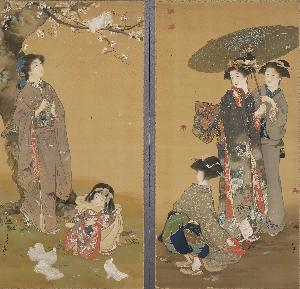Sakakibara Yuriko
Sakakibara Yuriko;Ikeda Shoen
Place: Tokyo
Born: 1886
Death: 1917
Biography:
Sakakibara Yuriko, also known as Ikeda Shoen, was a Japanese artist born in Tokyo in 1886. She was a prominent figure in the Nihonga and Ukiyo-e movements, and her work has been exhibited at the National Museum of Modern Art, Tokyo. Sakakibara Yuriko's life and work are emblematic of the expansive spirit and modernity of Meiji period Japanese culture.
Early Life and Education
Sakakibara Yuriko began studying with Mizuno Toshikata in 1901, where she met her future husband, Ikeda Terukata. She later joined the atelier of Kawai Gyokudo, a leading Nihonga painter who synthesized Japanese and Western painting traditions. Sakakibara Yuriko's education and training had a significant impact on her artistic style, which was characterized by **bold** and **vibrant** colors.
Artistic Style and Techniques
Sakakibara Yuriko's artwork often featured ink and colors on silk, as seen in her hanging scroll titled Yubae. Her use of color and composition was influenced by the Ukiyo-e movement, which emphasized **beauty** and **harmony**. Sakakibara Yuriko's artistic style was also shaped by her exposure to Western art and culture, which she encountered through her father's studies at Keio University.
Notable Works and Exhibitions
Some of Sakakibara Yuriko's notable works include:
- Yubae, a hanging scroll created around 1915
- Exhibitions at the National Museum of Modern Art, Tokyo
- Exhibitions at the British Museum
Sakakibara Yuriko's artwork can be found in the collections of the Matsuoka Museum of Art in Tokyo. Her work has also been featured on The Ukiyo-e Art Movement page on Wikioo.org, which showcases the history and techniques of the Ukiyo-e movement.
Legacy and Influence
Sakakibara Yuriko's legacy as a prominent figure in Japanese art is evident in her influence on later artists. Her use of color and composition has been studied by art historians and scholars, including those at Wikipedia. Sakakibara Yuriko's artwork continues to be celebrated for its **beauty** and **harmony**, and her contributions to the Nihonga and Ukiyo-e movements remain an important part of Japanese art history.

